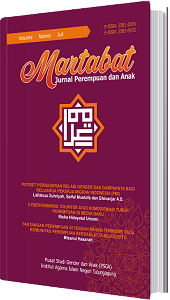Abstract
The purpose of this study is to discuss patterns of child sexual abuse that occur in the online games Minecraft and Hago. The crime of child sexual abuse with the "Online Child Grooming" mode in online games is regarded as an effective method for child predators to lure potential victims. Grooming is a process in which a perpetrator approaches a person or organization gradually through communication relationships with the intent of sexually harassing them. Victims are typically children, adolescents, or adults who are at risk of becoming harassed. This study employs activity routine theory, which assesses the absence of capable guardian factors, motivated actors, and the presence of suitable targets, all of which, if they occur at the same time and place, make child grooming possible. The research was conducted descriptively and qualitatively.
References
Babchishin, K. M., Hanson, R. K., & Hermann, C. A. (2011). The characteristics of online sex offenders: A meta-analysis. Sexual Abuse: Journal of Research and Treatment, 23(1), 92–123. https://doi.org/10.1177/1079063210370708
Baines, V. (2008). Online Child Sexual Abuse: The Law Enforcement Response. Journal of Digital Forensics, Security and Law, 4(4), 7–37. http://www.ecpat.net/sites/default/files/Thematic_Paper_ICTLAW_ENG.pdf
Brewster, T. (2019). Discord: The $2 Billion Gamer’s Paradise Coming To Terms With Data Thieves, Child Groomers And FBI Investigators. https://www.forbes.com/sites/thomasbrewster/2019/01/29/discord-the-2-billion-gamers-paradise-coming-to-terms-with-data-thieves-child-groomers-and-fbi-investigators/?sh=698b1ae37416
Choo, K. R. (2009). Online child grooming: a literature review on the misuse of social networking sites for grooming children for sexual offences. Australian Institute of Criminology, 132. http://www.ncjrs.gov/App/publications/Abstract.aspx?id=250455
Imran, M. F. (2015). Mutilasi dalam Perspektif Kriminologi: Tinjauan Teoritis Lima Kasus Mutilasi di Jakarta. Yayasan Pustaka Obor Indonesia.
Kramer, M., & Porter, M. E. (2019). Creating shared value: How to Reinvent Capitalism—And Unleash a Wave of Innovation and Growth. Harvard Business Review, 327–350. http://www.hks.harvard.edu/m-rcbg/fellows/N_Lovegrove_Study_Group/Session_1/Michael_Porter_Creating_Shared_Value.pdf
Maulida, L. (2018). Jumlah gamer di Indonesia capai 100 juta di 2020. https://www.tek.id/insight/jumlah-gamer-di-indonesia-capai-100-juta-di-2020-b1U7v9c4A
May-Chahal, C., & Emma, K. (2023). Online child sexual victimisation research. Online Child Sexual Victimisation, 17–54. https://doi.org/10.56687/9781447354529-006
McAlinden, A.-M. (2012). “Grooming” and the Sexual Abuse of Children. Oxford University.
Nathaniel, F. (2019). Cegah Pelecehan Seksual Anak, Pengetahuan Seks Jangan Jadi Tabu. https://tirto.id/cegah-pelecehan-seksual-anak-pengetahuan-seks-jangan-jadi-tabu-efAA
Pollack, D. (2015). clp. November 2015.
Puji Asmaul Chusna. (2017). Pengaruh Media Gadget Pada Perkembangan Karakter Anak. Dinamika Penelitian: Media Komunikasi Sosial Keagamaan, vol 17(no 2), 318.
Reddy, E., & Minnaar, A. (2015). Safeguarding children from becoming victims of online sexual abuse facilitated by virtual worlds. Child Abuse Research: A South African Journal, 16(1), 23–39.
Sukmadinata, N. S. (2006). Metode Penelitian Pendidikan. Remaja Rosdakarya.
Zarman, W. (2017). Ternyata Mendidik Anak Cara Rasulullah Mudah & Efektif. Kawan Pustaka.

This work is licensed under a Creative Commons Attribution-ShareAlike 4.0 International License.

